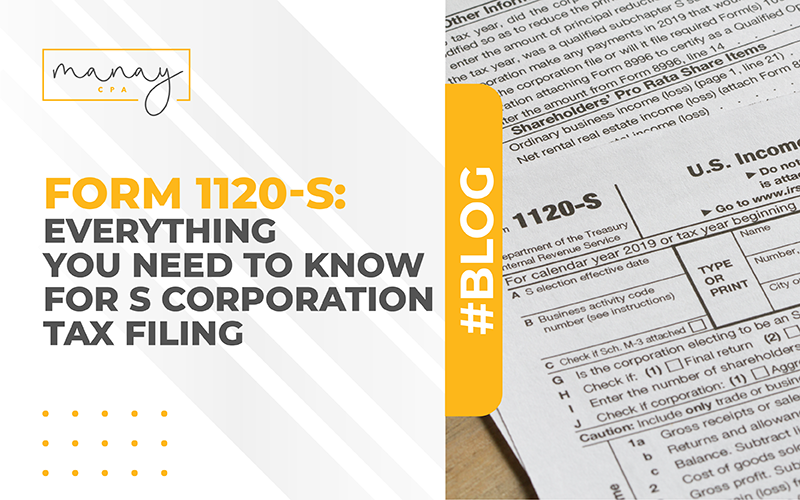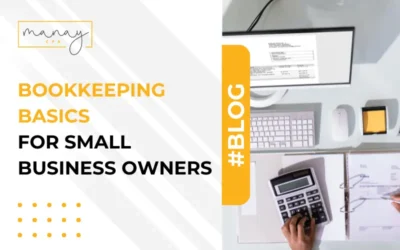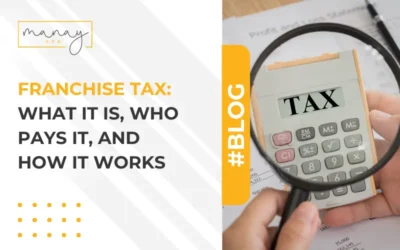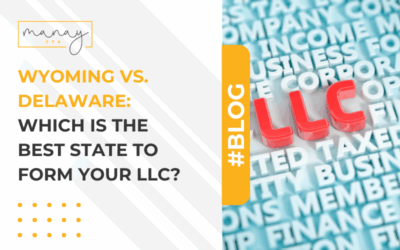Form 1120-S: Everything You Need to Know for S Corporation Tax Filing

As a business owner, filing taxes can be a daunting task. Staying on top of your tax obligations is essential to avoid complications. Form 1120-S is crucial in reporting S corporations’ income, losses, and deductions. It’s essential to understand what this form is, who needs to file it, and how to do it correctly to ensure your business stays compliant with the IRS. This article will cover everything you need about Form 1120-S, including the S Corporation tax structure, filing requirements, deadlines, deductions, and more.
Table of Contents
ToggleWhat is Form 1120-S, and who needs to file it?
Form 1120-S is the tax form S corporations use to report their income, deductions, and losses to the IRS. An S corporation is a type of business structure that allows for pass-through taxation, meaning that the business’s profits and losses are passed through to the shareholders and reported on their (individual) tax returns. It will enable the company to avoid double taxation, which occurs when the corporation and the shareholders are taxed on the same income. This pass-through taxation system is one of the most significant benefits of an S corporation.
If you’re running an S Corporation, you’ll need to file Form 1120-S every year, even if you didn’t have any income or activity during the year. The form is due on the 15th day of the third month after your corporation’s tax year ends. For example, if your tax year ends on December 31st, your Form 1120-S is due by March 15th of the following year.
Understanding the S Corporation Tax Structure
Before we dive into how to file Form 1120-S, let’s take a closer look at the S Corporation tax structure. Unlike a C Corporation, which pays taxes on its earnings, an S Corporation is a pass-through entity. The corporation passes through its income, deductions, and credits to its shareholders, who report them on their tax returns.
An advantage of the S corporation tax structure is that it stops business owners from being taxed twice. In a traditional corporation, the company pays taxes on its profits, and then the shareholders pay taxes on the dividends they receive. With an S corporation, the company’s profits are not subject to federal income tax, so the shareholders only pay taxes on their share of the income.
Step-by-Step Guide to Filing Form 1120-S
Filing Form 1120-S can seem overwhelming, but with a step-by-step approach, it can be manageable. Here is a brief guide to filing Form 1120-S:
- Gather all necessary documents: Before filling out the form, gather all the required documents, including financial statements, income statements, balance sheets, and other relevant documents.
- Fill out the basics: Start by filling out the basic information, such as the name and address of the S corporation, the date of incorporation, and the Employer Identification Number (EIN).
- Report income and deductions: Next, report the income and deductions of the S corporation. It includes reporting all sources of income, including sales, services, interest, and dividends. Deductions include expenses such as salaries, rent, and supplies. Identifying all the deductions an S corporation is eligible for is crucial. Overlooking certain deductions can lead to increased tax liability.
- Report shareholder information: Report the names and addresses of all shareholders and their ownership percentages. Reporting accurate shareholder information is essential to avoid potential IRS penalties.
- Sign and date the form: Once you have completed the form, sign, and date it, and include the contact information for the S corporation. An improperly filed Form 1120-S return can lead time-consuming and costly consequences.
Tips for Avoiding Common Form 1120-S Mistakes
Filing taxes can be stressful, but making mistakes on your Form 1120-S can lead to even more headaches. Thus, working with a tax professional experienced with Form 1120-S and can guarantee that the filing is prepared correctly and promptly is always advised. A professional may also assist you in identifying any credits or deductions that might be accessible to you and avoid any errors that might result in an audit or penalties.

Maximizing Deductions on Form 1120-S
S corporations can take advantage of several deductions to lower their taxable income. To maximize deductions on Form 1120-S, business owners should consider the following:
- Take advantage of all allowable deductions: Make sure to take advantage of all allowable deductions, including employee salaries, rent, and office expenses.
- Consider depreciation: Business owners can deduct the cost of certain assets over time through depreciation. It can help reduce the corporation’s taxable income.
- Remember start-up costs: Business owners can deduct up to $5,000 in start-up costs in the first year of operation. Any remaining costs can be deducted over 15 years.
- Consider health insurance premiums: S corporation shareholders who own more than 2% of the corporation can deduct their health insurance premiums on their tax returns.
S corporations can generally provide business owners with significant tax advantages. Still, consulting with a certified tax professional is crucial to guarantee you’re utilizing all allowable deductions and abiding by all relevant tax regulations.
Deadlines and Extensions for Form 1120-S
As mentioned, Form 1120-S is due on the 15th day of the third month after your corporation’s tax year ends. However, if you need more time to file, you can request an extension using Form 7004.
Form 7004 allows you to request an automatic six-month extension to file Form 1120-S. However, it’s important to note that an extension of time to file does not extend the time to pay any taxes owed. If you owe taxes, you must pay them by the original due date to avoid penalties and interest.
Calculating S Corporation Income and Losses
Calculating S Corporation gains and losses can be complicated, mainly when multiple shareholders exist. Here’s a basic overview of how S Corporation income and losses are calculated:
- Start with the corporation’s total income for the year
- Subtract any deductible business expenses
- Allocate the remaining income or loss among the corporation’s shareholders based on their percentage of ownership
- Report each shareholder’s share of the corporation’s income or loss on Form 1120-S
Remember that this is a simplified overview, and calculating S Corporation income and losses can be much more complicated in practice.
Reporting Shareholder Information on Form 1120-S
As an S Corporation, you must report each shareholder’s name, address, and share of the corporation’s income, deductions, and credits on Form 1120-S. The IRS uses this information to verify the corporation’s income and losses and ensure that the shareholders report the correct information on their tax returns. If your information needs to be corrected or turned out incomplete, it may delay the processing of your return and result in penalties.
Handling IRS Audits and Penalties for Form 1120-S
If the IRS decides to audit your S Corporation’s Form 1120-S, it must be followed correctly to avoid penalties or fines. Here are some tips for handling an IRS audit:
- Cooperate fully with the IRS
- Provide all necessary documentation and information
- If the audit is complex or you need help responding, seek professional help from a tax professional or accountant.
If the IRS finds that your S Corporation made errors on Form 1120-S, you may be penalized and fined. The penalty amount will depend on the severity of the error, so it’s essential to file your taxes correctly the first time.
Resources for Additional Form 1120-S Assistance
Filing Form 1120-S can be challenging, especially for business owners with limited experience with taxes. Filing Form 1120-S correctly is essential to avoid IRS penalties and ensure your S Corporation stays compliant.
Manay CPA is a reliable resource if you require more assistance with Form 1120-S. In addition to tax preparation and planning, our firm offers various accounting and taxation services. Manay CPA can provide the following service to assist with Form 1120-S:
- Tax planning: Manay CPA may assist you with tax planning by examining your company’s structure, earnings, and expenses to find potential deductions and credits.
- Tax preparation: Manay CPA may prepare and submit Form 1120-S on your behalf, ensuring that all pertinent information is included and the form is submitted accurately and on time. We can also help with various tax schedules and forms.
- Consulting: Manay CPA can offer consulting services for your company, such as assisting you in navigating challenging tax situations or providing guidance on the tax ramifications of business decisions. We can also offer advice on financial planning and business strategy.
Schedule a free consultation with our team today to learn more about S corporation tax filing and receive expert guidance from licensed CPAs. We are here to help you maximize deductions, avoid common mistakes, and ensure compliance with IRS regulations. Click here to schedule your free consultation now.

Published on: 28 March 2023
Last updated on: 05 August 2024
Manay CPA is a reputable, full-service CPA firm based in Atlanta, Georgia. Founded in 2001, we provide comprehensive accounting and tax solutions to individuals and businesses across all 50 states.





